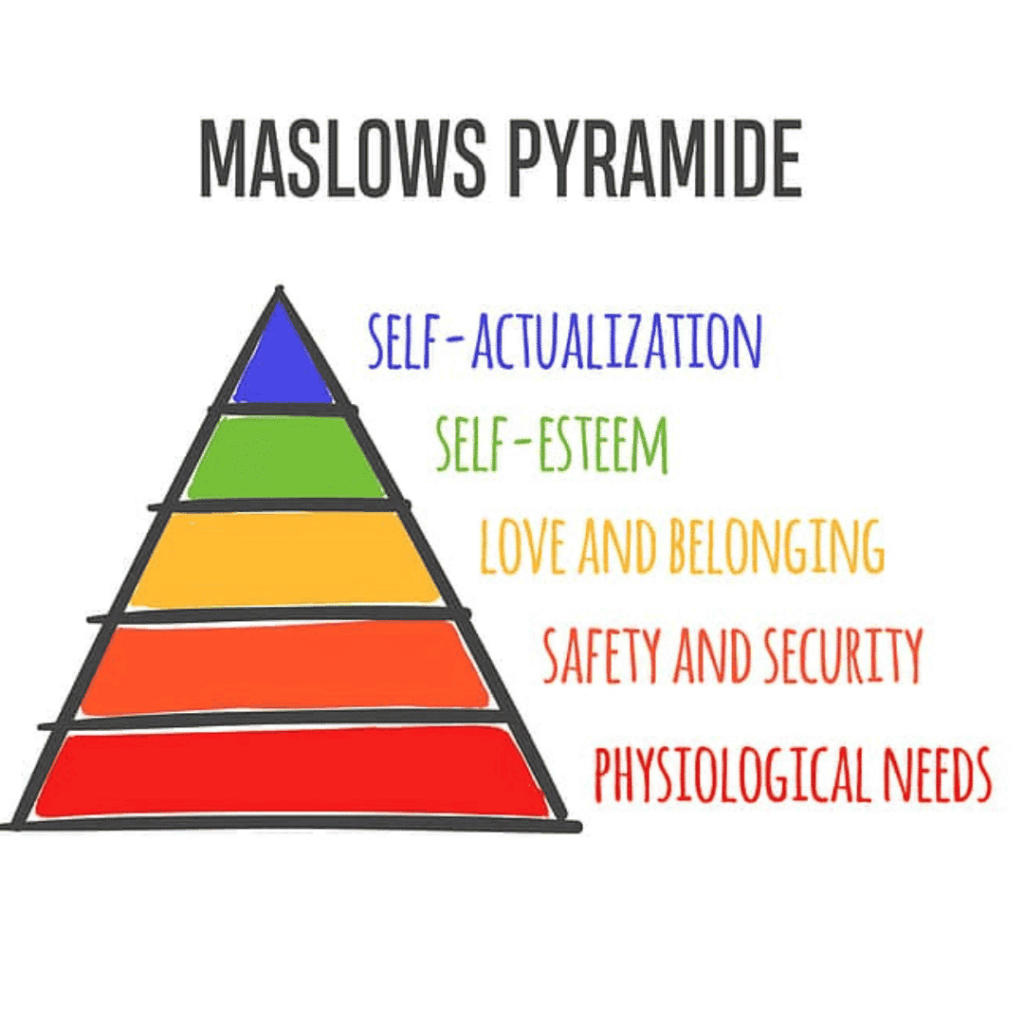Background – Abraham Maslow
Abraham Harold Maslow (1908-1970) was an American psychologist who was best known for developing the theory of the hierarchy of needs (need pyramid). Maslow, who is considered the founder of humanistic psychology, usually wrote on topics such as behavioral and motivation theory in the research area of comparative behavioral science and presented his “hierarchy of needs according to Maslow” or “hierarchy of needs according to Abraham” for the first time in 1943 in a work entitled ” A Theory of Human Motivation “.
According to this theory, the behavior of people and the resulting image of man is designed as follows: Actions of people are motivated by the desire to meet certain physiological needs, social needs and psychological needs. In Maslow’s hierarchy of needs, five types of needs are distinguished, which are satisfied one after the other. Abraham Harold Maslow proposed in his theory that describes five hierarchical needs that can also be applied to an organization, management and the performance of its employees. According to Maslow’s theory, one feels the second need only when the first is satisfied, or the second when the second is satisfied, or the third when the second is satisfied, and so on.
Basic assumption and definition
The basic assumption and definition of Maslow’s hierarchy of needs is that humans are born with certain basic needs, which can be classified according to their importance in a tiered model. Our most basic needs are physiological needs, followed by social needs, financial security, health security, social needs, and finally the need for self-actualization.
The idea behind this is that as we meet our most basic needs in life, we are able to move up and meet the more complex needs that are represented at the higher levels, but only so long as until our most basic needs are met.
The eight levels of the hierarchy of needs were later adjusted by others based on Maslow’s work.
It can be argued that the original five-stage model later included additional sixth, seventh, and eighth stages (cognitive, aesthetic, and transcendent) within the original self-realization stage 5, since each of the new motivators affects an area of self-development and creative fulfillment that is in the growth of self-realization is rooted and clearly different from the earlier “deficiency” motivators of levels 1-4.
Abraham Maslow distinguishes five levels of need
The key to understanding Maslow’s hierarchy of needs lies in realizing that your needs are constantly changing. So what motivated you five years ago or even a month ago may no longer motivate you today.
There are several ways to disassemble the model at a high level, which you can see on the right and left sides of the pyramid.
The first possibility is to subdivide the model into need for deficiency and need for growth. Deficiency needs are sometimes referred to as D needs. These are the needs that motivate people when they are left unsatisfied. The longer the deficit needs remain unsatisfied, the stronger the desire to meet those needs; therefore, need satisfaction is crucial in order to avoid unpleasant feelings and for subjective well-being or even death in the case of psychological needs. For example, the longer you have to go without water, the more important it becomes for you to get water. If you die of thirst, you won’t be interested.
According to the model, one is initially motivated to meet one’s lowest needs and only when that is done does one move on to being motivated by the next level of needs, and this process continues until one reaches self-actualization.
Although the theory was originally proposed as a very rigid hierarchy, Maslow later modified it so that advancement in the hierarchy does not have to be quite so strict. And that the levels can overlap to a certain extent. This makes sense, because for some people reaching the fourth status level can be more important than z. B. Love, which is level 3.
Let’s start with the details of each stage:
Level 1: Basic Physiological Needs
These are the basic physical needs that you have to meet in order to survive and are the starting point of Maslow’s hierarchy of needs. They are essential to your survival. These needs include food to eat, water to drink, air to reproduce, shelter to protect yourself from the elements, warmth to keep from freezing, and sleep to recover. Note that Maslow also included sex as a basic physical need in this category, as reproduction is essential for the survival of the human species.
Level 2: security needs
The second level is safety needs, and once you have your physiological needs met, the next needs that you seek to satisfy are those safety needs. We all want to feel safe and secure, and those needs include being free from war, natural disasters, and violence. Examples from the world of work: In the workplace, these needs include things like job security, a safe work environment, the ability to grieve, save some money every month, and know that you have health insurance if you get sick.
Psychological and security needs together are called basic needs.
Level 3: Social Needs
The third level is social needs. At this level you have a desire to develop your interpersonal relationships. You want to feel like you’re part of a group. These things include intimacy, friendship, and family. According to Maslow’s concept, at this level you have the need to belong to one or more groups, which can be family groups or social groups. Belonging to a group is commonly referred to as belonging, and that means joining a group or club. Feeling that you are loved, that you are cared for, and that you belong to a group can help you avoid loneliness, anxiety, and depression.
Level 4: Appreciation needs or self-esteem needs
The next level is the appreciation needs or self-esteem needs. These needs are your ego needs and your status needs.
At this level, you will be motivated by receiving recognition from others, achieving high status, being respected, and feeling important. In short, you want to feel that you are contributing to the world and that others recognize your contribution.
According to Maslow, there are two groups of needs for appreciation: the lower esteem and the higher esteem.
The lower esteem is simply the need for respect from others, while the higher esteem is self-esteem. Note that imposter syndrome can occur when your needs for lower appreciation are met but your needs for higher appreciation remain unmet.
Level 5: individual needs – self-realization
The last and highest level in Maslow’s hierarchy are the self-actualization needs or needs for self-actualization.
This is the urge to be the best one can be. It’s about reaching your full potential as a human being. You can think of the first four levels of the hierarchy as a series of levels that you must master to reach the top of the five levels. Since each of us is unique on this final level, each of us will choose an individual level at which to excel. That could be the desire to be the best parents. It could be a desire to be the best athlete anyone could be, it could be a desire to create the most beautiful art, but it is something unique and it is something that will motivate you and only you.
Maslow’s expansion: The 7-level hierarchy of needs
There are a few varieties of Maslow’s hierarchy of needs that you should be aware of. In 1970, Maslow expanded its original five-tier model in two cases.
The first two now also include cognitive and aesthetic needs, and later transcendent needs are added.
Let’s talk about the cognitive needs: once you have met your efficiency needs, Maslow believed that expanding your knowledge would then motivate you. The cognitive needs reflect our need to discover, experiment, and learn how the world around us works in order to expand our understanding – this is a crucial step on the path to self-actualization as it is about your mind too while exploring new ideas based on facts. Aesthetic needs
This can mean appreciating the good things in life, but it can also mean finding balance. For example, taking a walk in nature can make us feel refreshed; likewise, experiencing music can induce a feeling of rejuvenation. When we satisfy our aesthetic needs, we feel closely connected to the beauty of the world around us.
transcendence
The second update Maslow made kept deficit needs and added a final layer to growth needs, transcendence. Transcendence is now at the top of the pyramid and relates to the satisfaction of our spiritual needs. We are motivated by values that go beyond ourselves.
Why is Maslow’s hierarchy of needs so important?
Maslow’s need pyramid is one of the most legendary ideas in the history of psychology, especially social psychology. It is found in an inconspicuous triangle or pyramid that has become a deeply influential pyramid.
It was first published in an academic journal in the United States in 1943, where it was drawn in crude black and white and surrounded by dense and jargon-rich text. Since then, it has become a mainstay of psychological analysis, business presentations and TED talks , and it has become more and more colorful and emphatic.
The pyramid was the work of the then thirty-five-year-old Jewish psychologist of Russian descent, who since the beginning of his professional career would not have been part of the close-knit Orthodox family of his youth for nothing less than the meaning of life.
Maslow wanted to find out what could make life meaningful for people in modern America, a country where the pursuit of money and fame seemed to have dwarfed any other inner or authentic pursuit. He saw in psychology the discipline that would enable him to answer the longings and questions that people had once thought to be religion. He saw in psychology the discipline that would enable him to answer the longings and questions that people had once thought to be religion. He suddenly realized that humans essentially have five different types of needs. On the one hand the psychological or what could be called the spiritual without any mysticism, and on the other hand the material.
Advantages and disadvantages of Maslow’s need pyramid
There are several advantages and disadvantages associated with Maslow’s hierarchy of needs.
advantages
As for the benefits, the model is easy to understand at a basic level. It expresses the human desire to achieve something and have more and more over time. It’s a holistic approach to motivation. Maslow’s model helps us understand that an employee or person will not be motivated to perform even if he / she is promised a great reward when he / she is tired, cold, and hungry.
disadvantage
Now we come to the disadvantages:
There is no way to empirically test Maslow’s concept of self-actualization.
It doesn’t take into account the cultural differences. For example, the need to feel belonging will be higher in certain countries like China than in other countries like the US. In addition, each person will evaluate each need differently. Appreciation needs can be important to you, while your counterpart may place more value on security needs. Van Gogh, for example, realized himself through his art, but lived in poverty all his life.
In reality, we usually don’t focus on satisfying one need for another. Instead, we try to meet many needs at the same time.
Bottom line
In short, Maslow’s hierarchy must show that our motivations are constantly changing. This means that what motivated you last year is unlikely to motivate you this year or today. Maslow’s original hierarchy was divided into five levels. A person who starts at the lowest level in the hierarchy is not motivated until the needs at that level are met by trying to meet the needs at the next level. By and large, the model can be broken down into two categories of needs: first, there are deficit needs, which motivate us when they are not there, and, second, growth needs, which motivate us to grow and get the best out of what we can.









